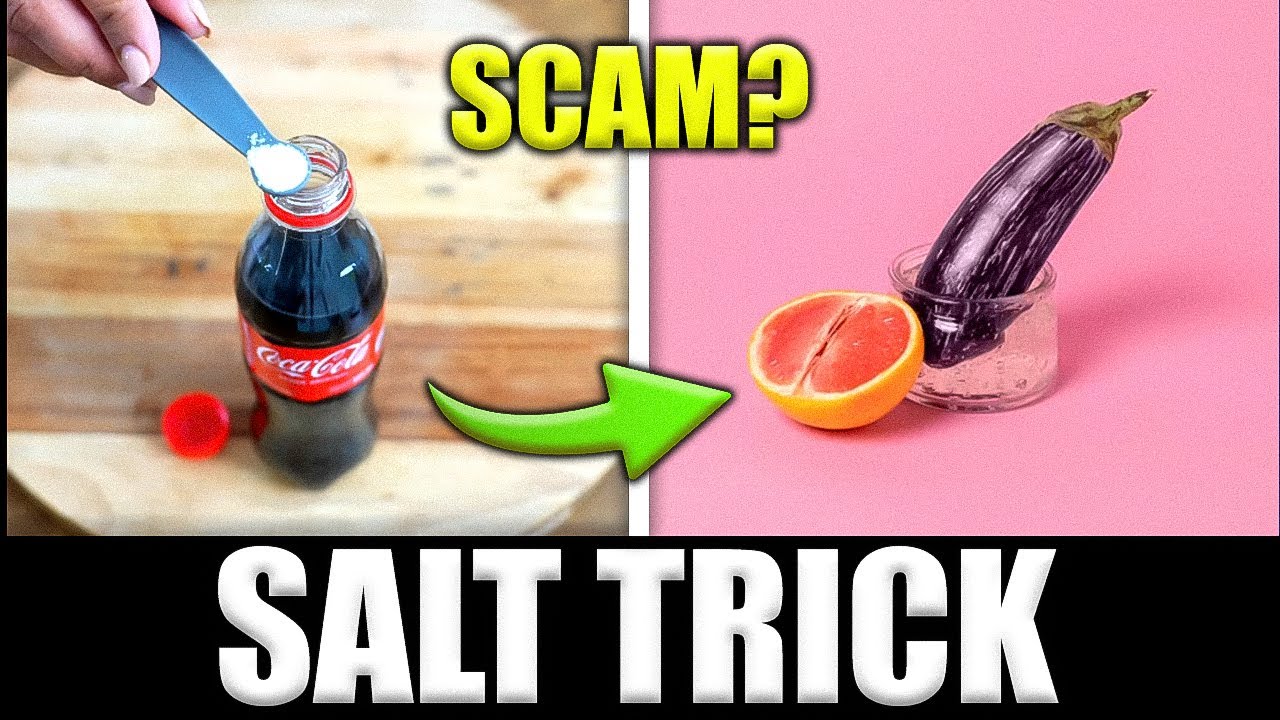What Is The Salt Trick? Discover The Science, Benefits, And Applications
Have you ever wondered what the salt trick is and how it works? The salt trick is a fascinating scientific phenomenon that has been used in various applications, from cooking to industrial processes. This simple yet powerful technique involves the use of salt to alter the properties of water, ice, or other substances. Understanding the science behind the salt trick can help you unlock its potential in everyday life.
The salt trick is not just a fun experiment; it is a practical solution with numerous real-world applications. From de-icing roads in winter to enhancing cooking techniques, the salt trick plays a significant role in improving efficiency and safety. Whether you're a home cook, a scientist, or simply curious about the world around you, this article will provide you with an in-depth understanding of the salt trick.
In this comprehensive guide, we will explore the science behind the salt trick, its applications, benefits, and potential drawbacks. By the end of this article, you will have a clear understanding of how the salt trick works and how you can apply it in your daily life. Let's dive in!
Read also:How To Set Up Remote Access For Raspberry Pi Iot Projects
Table of Contents
- The Science Behind the Salt Trick
- How Salt Affects Temperature
- Real-World Applications of the Salt Trick
- The Salt Trick in Cooking
- Salt Trick for De-Icing Roads
- Environmental Considerations
- Health Implications of Salt Usage
- Alternatives to the Salt Trick
- Conducting Your Own Salt Trick Experiment
- Conclusion: Embrace the Salt Trick Wisely
The Science Behind the Salt Trick
The salt trick primarily involves the process of freezing-point depression. When salt is added to water, it disrupts the molecular structure of water, preventing it from freezing as easily. This phenomenon occurs because salt ions interfere with the formation of ice crystals, lowering the freezing point of water. As a result, water mixed with salt remains in its liquid state at lower temperatures than pure water.
This scientific principle is rooted in colligative properties, which are properties of solutions that depend on the number of particles dissolved in a solvent rather than the type of particles. Salt, being an ionic compound, dissociates into sodium (Na⁺) and chloride (Cl⁻) ions when dissolved in water. These ions increase the number of particles in the solution, thereby lowering the freezing point.
Key Components of the Salt Trick
- Salt (NaCl): The primary ingredient used in the salt trick.
- Water: The solvent where salt is dissolved to create the solution.
- Temperature: The key factor affected by the salt trick, as it lowers the freezing point of water.
Understanding these components is essential for effectively utilizing the salt trick in various applications.
How Salt Affects Temperature
Salt's ability to lower the freezing point of water is a well-documented phenomenon. When salt is added to water, it creates a solution that remains liquid at lower temperatures. This is why salt is commonly used to melt ice on roads during winter. The freezing point of water decreases by approximately 1.86°C for every mole of salt dissolved in a kilogram of water.
This temperature change is not limited to freezing points; it also affects boiling points. Adding salt to water increases its boiling point slightly, making it boil at a higher temperature than pure water. While the difference is minimal, it can have significant effects in certain applications, such as cooking pasta or boiling eggs.
Practical Implications of Temperature Changes
- De-icing Roads: Salt helps melt ice and snow on roads, improving safety during winter.
- Cooking: Adding salt to water can enhance the texture and flavor of cooked foods.
- Ice Cream Making: Salt and ice are used together to create the cold temperatures needed for churning ice cream.
Real-World Applications of the Salt Trick
The salt trick is widely used in various industries and everyday activities. Its ability to alter the physical properties of water makes it an invaluable tool in many applications. From household chores to large-scale industrial processes, the salt trick plays a crucial role in enhancing efficiency and safety.
Read also:Smartstocks Ai Platform Revolutionizing Stock Market Trading With Artificial Intelligence
Some of the most common applications of the salt trick include:
- Road Safety: Salt is spread on roads and highways to prevent ice formation and improve traction during winter.
- Food Preparation: Salt is added to water to enhance cooking processes and improve the taste of food.
- Ice Cream Production: Salt and ice are combined to create the low temperatures needed for churning ice cream.
These applications demonstrate the versatility and importance of the salt trick in modern life.
The Salt Trick in Cooking
In the culinary world, the salt trick is a well-known technique used to enhance cooking processes. Adding salt to water before boiling pasta or vegetables not only improves their flavor but also affects their texture. The salt increases the boiling point of water slightly, allowing food to cook more evenly and thoroughly.
Benefits of Using the Salt Trick in Cooking
- Enhanced Flavor: Salt brings out the natural flavors of food, making dishes more delicious.
- Improved Texture: Boiling food in salted water can result in a firmer and more appealing texture.
- Faster Cooking: Slightly elevated boiling temperatures can reduce cooking times, saving energy and resources.
However, it is important to use salt in moderation to avoid excessive sodium intake, which can have negative health effects.
Salt Trick for De-Icing Roads
One of the most significant applications of the salt trick is in de-icing roads during winter. Road safety is a critical concern when snow and ice accumulate on highways and streets. Salt is spread on roads to lower the freezing point of water, preventing ice from forming and improving traction for vehicles.
According to the National Snow and Ice Data Center, salt is one of the most effective and widely used de-icing agents. It is estimated that millions of tons of salt are used annually in the United States alone for road de-icing purposes.
Challenges in Road De-Icing
- Environmental Impact: Excessive use of salt can harm nearby plants, soil, and water sources.
- Corrosion: Salt can accelerate the rusting of vehicles and infrastructure, leading to increased maintenance costs.
- Effectiveness Limitations: Salt becomes less effective at extremely low temperatures, requiring alternative solutions in colder climates.
Environmental Considerations
While the salt trick is highly effective in many applications, its environmental impact must be carefully considered. Excessive use of salt can lead to soil degradation, water pollution, and harm to aquatic life. Salt runoff from roads can contaminate nearby water sources, affecting ecosystems and wildlife.
Studies conducted by environmental organizations highlight the need for sustainable practices in salt usage. Implementing measures such as using alternative de-icing agents, reducing salt application rates, and improving drainage systems can help mitigate these environmental concerns.
Strategies for Sustainable Salt Usage
- Use Alternative De-Icing Agents: Products like calcium chloride and magnesium chloride are effective alternatives to traditional salt.
- Optimize Application Techniques: Precise application methods can reduce the amount of salt needed while maintaining effectiveness.
- Monitor Environmental Impact: Regular testing of soil and water quality can help identify and address potential issues caused by salt runoff.
Health Implications of Salt Usage
Excessive salt consumption can have negative health effects, including high blood pressure, heart disease, and stroke. While the salt trick is primarily used in external applications, it is important to be mindful of salt intake in cooking and food preparation. The World Health Organization recommends limiting daily sodium intake to less than 5 grams (approximately one teaspoon) to maintain good health.
For individuals with certain medical conditions, such as hypertension or kidney disease, reducing salt intake is crucial. Understanding the role of salt in cooking and its potential health implications can help individuals make informed dietary choices.
Tips for Reducing Salt Intake
- Use Herbs and Spices: Enhance the flavor of food with natural seasonings instead of relying on salt.
- Read Labels: Check the sodium content of processed foods and choose low-sodium options when possible.
- Cook from Scratch: Preparing meals at home allows you to control the amount of salt used in your food.
Alternatives to the Salt Trick
While the salt trick is highly effective, there are alternative methods and products that can achieve similar results with fewer environmental and health concerns. These alternatives are particularly useful in situations where excessive salt usage is not desirable.
Some popular alternatives to the salt trick include:
- Sand: Provides traction on icy surfaces without altering the freezing point of water.
- CaCl₂ (Calcium Chloride): A more effective de-icing agent than traditional salt, especially at lower temperatures.
- Beet Juice: A natural de-icing agent that can be combined with salt to enhance its effectiveness and reduce environmental impact.
Exploring these alternatives can help reduce the reliance on traditional salt while maintaining the benefits of the salt trick.
Conducting Your Own Salt Trick Experiment
If you're curious about the salt trick and want to see it in action, conducting a simple experiment at home is a great way to learn more. All you need is some salt, water, and ice. Follow these steps to observe the effects of the salt trick:
- Fill two cups with water and freeze them overnight to create ice cubes.
- Place the ice cubes in two separate bowls.
- Sprinkle salt on one of the ice cubes and leave the other one untreated.
- Observe the difference in melting rates between the two ice cubes.
This simple experiment demonstrates the principle of freezing-point depression and highlights the effectiveness of the salt trick.
Conclusion: Embrace the Salt Trick Wisely
In conclusion, the salt trick is a powerful and versatile technique with numerous applications in everyday life. From improving road safety during winter to enhancing cooking processes, the salt trick plays a crucial role in enhancing efficiency and convenience. However, it is important to use salt responsibly and consider its environmental and health implications.
We encourage you to explore the possibilities of the salt trick and experiment with its applications. Share your experiences and insights in the comments below, and don't forget to explore other articles on our website for more informative content. Together, let's embrace the salt trick wisely and make the most of this fascinating scientific phenomenon!
Article Recommendations


